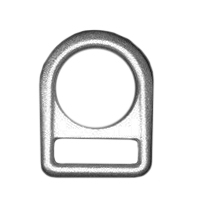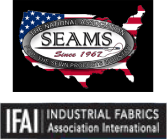Latest Posts
- Part 1 of 4 Series - Bow to Stern: Metal and Plastic Hardware Posted: 3/20/2019
- FR Treatments Explained Posted: 3/20/2019
- What is a DWR Treatment? Posted: 3/20/2019
- What Is Elastic and When Should You Use It? Posted: 3/20/2019
- Hook and Loop for Orthotics and Prosthetics Posted: 3/20/2019
Buyers Guide to Metal Hardware
Posted: 5/7/2015
By: Terri Shadrix

Buyers Guide to Metal Hardware – Materials, Finishes and Processing for Buckles, Hooks, Loops, Rings
What do we mean when we say “metal hardware"? There are so many different materials that are classified as metal available in different finishes and price points that it's easy to get confused.
How to do you decipher the choices and not over spend on material that is not necessary for your application? Or even worse, how do you avoid under shooting the quality and dependability you really need in your hardware and risk a product failure?
The key is finding the right combination of material and finish for your application by understanding the attributes of the materials, and their pros and the cons, so you can be sure to hit the preverbal “nail on the head" with your choice. To help metal hardware buyers in selecting the options that are best for their products, DirecTex has put together a brief overview of popular materials and finishes.
COMMON 'METAL' MATERIALS:
Let's begin with the very foundation of a metal hardware piece - the material. Below are the most common materials used to product metal hardware:
Steel Wire
Steel wire is widely used in forming D-Rings, O-Rings, Tri-Rings and Loops. The raw steel comes in roll that is rolled into wire. The wire is available in different thickness known as gauges. Interestingly, the larger the gauge number the smaller the diameter of the wire. The wire parts can be welded and usually have a finish applied. This is a fairly simple manufacturing process resulting in inexpensive per-piece costs. Furthermore, special tooling for custom parts is also inexpensive. These factors make it possible to get custom sizes with a relatively small investment.
Sheet Steel
This material is used in industrial buckles which are stamped out (think an industrial version of the kitchen cookie-cutter tool). Raw material comes in wide sheets or strips which is run through a stamping machine. This is an inexpensive process which is easy to work with. To deter the inevitable rusting of an exposed steel, each freshly stamped raw product usually has a finish applied.
Stainless Steel
Stainless steel is similar to sheet steel and steel wire in its raw material state. However, it offers advantages not found in non-stainless steel. Stainless steel is stronger, does not rust, and does not require polishing. Because of its strength it is harder to manufacture resulting in a higher price point than standard steel. Stainless Steel is ideal for marine applications or places where exposure to moisture can accelerate rust.
Zinc Die-Cast
In this process the raw material is actually melted and poured into a mold for manufacturing. The process is similar to that of plastic manufacturing. Zinc die-cast parts are extremely rust resistant, do not require plating and are uniform in shape and dimension. Zinc die-cast pieces have a lower breaking point then steel wire or stamped items and have a higher price point.
Malleable Iron
In this process the very heavy raw iron material is pressed or molded into shape making a very strong piece of hardware. These strong and heavy pieces are often used in the Equestrian industry due to these attributes. Malleable Iron is a cost effective option to solid nickel or solid brass pieces as it can be plated to offer the same look. This material and process is more expensive that standard steel because of its strength and durability.
Solid Brass
Raw material is an alloy of copper and zinc which is poured into molds similar to the process for ZDC parts. This material is strong, long lasting and will not rust. Metal hardware produced with this material are ideal for both the equestrian and marine industries. However, they have a higher price point than other options and require polishing to prevent oxidation.

METAL HARDWARE FINISH OPTIONS:
Now that you have found the material for your metal hardware part, you will want to consider the finish options and processes that are available to complete your piece.
Nickel Finish
Nickel plating is one of the oldest and most popular finishes used. Its silver color greatly improves the appearance of metal and it helps prevent corrosion. Nickel plating is an inexpensive option but it can tarnish and because it is a hard finish may crack over time.
Zinc Finish
A zinc finish should not be confused with zinc material. It is a very popular finish similar in color to nickel but with a more blueish undertone. It is also an inexpensive option like nickel, but is softer and will not crack or peel. However it does not hold up against rust as well as nickel.
* To illustrate how universally popular these two finishes are, nickel and zinc plating represent 75% of the finishes sold by DirecTex.
Black Enamel
Black Enamel is a high quality finish that is applied over copper base finish for greater resistance to rust. The finish can be shiny or dull matte black. Black enamel holds up as well as special zinc (see below) to salt spray test. This is a very high-end looking finish that adds dimension to your project. It is a slightly higher price point then nickel or zinc but adds a lot to a project.
Hot Dipped Zinc (Special Zinc)
Hot dipped zinc is a good alternative to cadmium as it is more environmentally friendly and withstands salt spray test as good as cadmium. It is also is a very cost effective option. Hot dipped zinc is used in the tent and awning industry because of its resistance to elements.
Cadmium
Cadmium is similar to the color of zinc, has a very good salt spray and rust resistance. However, it is very harmful to the environment and very expensive. For these reasons it is a very specialized finished primarily used in the aerospace industry.
PLATING PROCESSES:
Now that you have chosen the material and finish, here is a little information on “plating" processes.
Barrel Plating
Once parts have been produced they are placed in a large vat or barrel that contains platting liquids. Once plating has had time to adhere to the metal material the parts are removed and dried. This is a very inexpensive and easy process.
Rack Plating
In this process produced pieces are placed one by one on a plating rack the rack is then submerged into the plating liquids. Once the plating has time to adhere to the metal material the rack is removed and the parts are left hanging to dry. Provides a very high quality finish but is a very labor intensive and relatively expensive process.
NEXT STEPS:
So hopefully this short summary of materials, finishes and processes helps shed light on the factors to weigh when deciding between options. But don't guess. If you're unsure just Contact Us. We've probably solved the equation before.
Or we can partner with you to test various options to see which ones meet your exact specifications. DirecTex has a material testing team to help you figure it out. Read more about the DirecTex Material Testing Lab.




